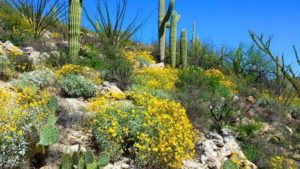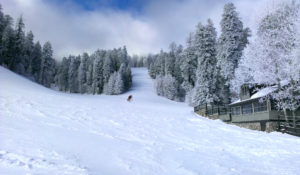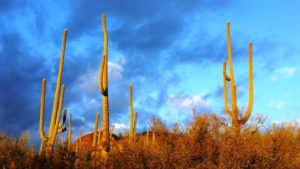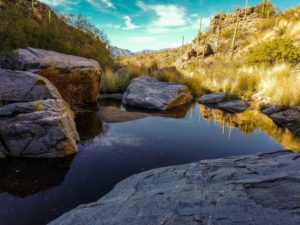
The desert in bloom viewed along Tucson’s Agua Caliente Hill trail.
We’ve finally had a touch of winter here in Tucson, where temperatures reached into the high 80s in early February and it felt like summer back east.
At the end of February, while cooling rains pelted the parched city, snow fell atop 9,147-foot Mt. Lemmon in the Catalina Mountains just north of Tucson. Mt Lemmon is the site of the southernmost ski area in the United States. (Temperatures at the summit can turn 30 degrees colder than those in the city, which sits some 7,000 feet below.)
That’s good news for Tucson hikers and anyone who values the surprisingly rich life of the desert. With refreshing spring rains, dry creek beds turn into gushing waterfalls, wildflowers bloom and hikers and picnickers flock to newly lush surroundings.
As I write in my book 100 Things to Do in Tucson Before You Die, you can set aside any notions of the desert (in this case the Sonora Desert) being a stark place with little plant and animal life.
A visit to Tucson’s top tourist attraction, the Arizona-Sonora Desert Museum, will change your mind forever.

Mt. Lemmon’s winter snows bring spring flowers
Primarily an outdoor experience, it covers 21 acres harboring some 1,200 types of plants and 300 animal species. You can take trails to catch possible sightings of wild pig-like javellinas, wildcats, coyotes, and bighorn sheep, or you can stroll through a landscaped cactus garden and a hummingbird aviary.
You’ll discover that the desert is a thriving complex ecosystem — and anything but deserted.
Hiking in the Mountains and Amid Saguaros
Popular Sabino Canyon — with its palm trees, cacti and glimpses of local wildlife in the foothills of the Catalinas just north of Tucson — is transformed into a virtual desert oasis in March and April. It’s crisscrossed with trails ranging from easy nature walks to steep, rugged treks.
Saguaro National Park — home to thousands of its namesake giant cacti spread over more than 90,000 acres — is separated into two sections (East and West) by the city. Saguaro East, in the Rincon Mountains, is the larger of the two, but both offer scenic drives, hiking trails, nature walks, horseback rides, and picnic spots.

Saguaros along the Blackett’s Ridge Trail. Photo by Bill Bens.
Saguaros, the stately cacti that have served as the backdrop for countless Western movies, are found only in the Sonoran Desert. With their characteristic “arms,” heights up to 50 feet, and lifespans up to 200 years, Saguaros have been dubbed “Sentinels of the Desert” — standing watch, in effect, of all other life forms in this arid land.
And Catalina State Park, leading up into the craggy Catalina Mountain foothills northwest of the city, finds water coursing into its streams, pools, and waterfalls.
Trails off the Beaten Path
If you’re looking for some lesser-known, but still spectacular hiking experiences in the Tucson area, I suggest you check out the blog post Three Incredible Hikes in Tucson from my friend Mitch Stevens, founder of the highly recommended company Southwest Discoveries and a valued guest poster on this site.
Mitch, a veteran (baby boomer) Sierra Club guide, leads guided hikes throughout Arizona and parts of adjoining states and knows his stuff.
You can read about the Wildhorse Trail in Saguaro National Park East, where, as Mitch writes, you are “virtually assured of solitude”; the Blackett’s Ridge Trail, which winds high above Sabino Canyon; and the nine-mile challenging and deceptively named Agua Caliente Hill, with a summit of 5,500 feet.

The Wildhorse Pool in Saguaro National Park.
With the “hill’s” 2,800-foot elevation gain, I’m going to have to work up to that one, though Mitch points out there’s a good turnaround spot at the 1.7 mile mark.
Anytime you’re hiking in the mountains around Tucson, be sure to carry plenty of water and wear sunscreen and preferably a broad-rimmed hat. Be wary of getting caught in canyons during flash floods.
Note to readers: If you’re in the Tucson area, please stop by to see me at the Tucson Festival of Books (the nation’s third largest book fest) on March 10-11, where I’ll be selling my book 100 Things to Do in Tucson Before You Die. One of the 100 Things to Do, conveniently, is to attend the Tucson Festival of Books, so you’ll be able to cross that one off your list!
Thanks, and hope to see you there!












2 Responses to Spring in Tucson: Desert in Bloom